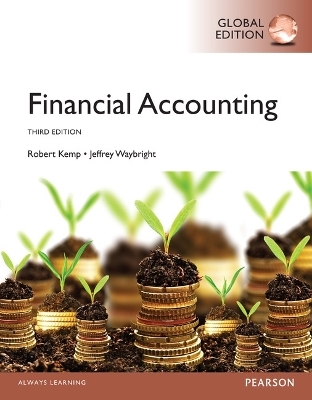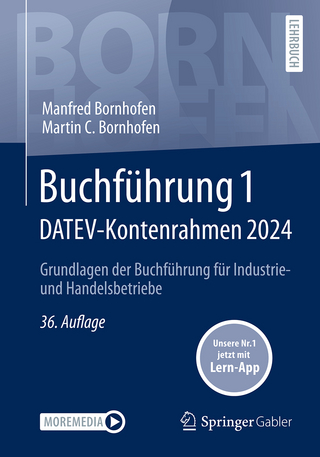
Financial Accounting, Global Edition
Pearson Education Limited (Verlag)
978-1-292-01954-3 (ISBN)
Once students see that accounting is the language of business, they are on their way to academic and professional success. Financial Accounting, Third Edition translates the essentials of accounting to students so they understand why and when financially sound decisions are made in business today.
Teaching and Learning Experience
This program presents a better teaching and learning experience–for you and your students. With Financial Accounting, Third Edition you will,
Personalize learning with MyAccountingLab®: MyAccountingLab provides instructors with a rich and flexible set of course materials, along with course-management tools that make it easy to deliver all or a portion of your course online.
Use a text with strong pedagogy tools to create a clear learning path: Students are able to acquire, understand, and retain important information by completing exercises, learning key terms, participating in discussion questions, following critical thinking activities and more.
Present fundamental accounting principles by using current real-world examples: Up-to-date information prepares students for working in their field.
Illustrate tough concepts using visuals: The text presents the connection between accounting equations and big picture concepts by using striking visuals.
Please note that the product you are purchasing does not include MyAccountingLab.
MyAccountingLab
Join over 11 million students benefiting from Pearson MyLabs.
This title can be supported by MyAccountingLab, an online homework and tutorial system designed to test and build your understanding. Would you like to use the power of MyAccountingLab to accelerate your learning? You need both an access card and a course ID to access MyAccountingLab.
These are the steps you need to take:
1. Make sure that your lecturer is already using the system
Ask your lecturer before purchasing a MyLab product as you will need a course ID from them before you can gain access to the system.
2. Check whether an access card has been included with the book at a reduced cost
If it has, it will be on the inside back cover of the book.
3. If you have a course ID but no access code, you can benefit from MyAccountingLab at a reduced price by purchasing a pack containing a copy of the book and an access code for MyAccountingLab (ISBN: 9781292019734)
4. If your lecturer is using the MyLab and you would like to purchase the product....Go to www.myaccountinglab.com to buy access to this interactive study programme.
For educator access, contact your Pearson representative. To find out who your Pearson representative is, visit www.pearsoned.co.uk/replocator
1. Business, Accounting, and You
Business, Accounting, and You
What Is a Business, and Why Study Accounting?
The Definition of a Business
The General Concept of Value
Business Owners and Other Stakeholders
The Goal of a Business
How Does a Business Operate?
Resources Needed to Start and Operate a Business
Operating the Business
The Cost of Money
How Are Businesses Organized?
The Types of Businesses
The Legal Forms of Businesses
What Is Accounting, and What Are the Key Accounting
Principles and Concepts?
Generally Accepted Accounting Principles
International Financial Reporting Standards
The Business Entity Principle
The Reliability (Objectivity) Principle
The Cost Principle
Accounting Ethics: A Matter of Trust
What Is the Role of Accounting in a Business?
How Do You Recognize a Business Transaction?
Cash Accounting
Accrual Accounting
How Do You Measure a Business Transaction?
How Do You Record Business Transactions Using the Accounting Equation?
Transaction Analysis
Stockholders Equity
How Do You Report Business Transactions Using Financial Statements?
The Income Statement
The Statement of Retained Earnings
The Balance Sheet
The Statement of Cash Flows
Relationships Among the Financial Statements
Accounting, Business, and YouPutting It All Together
Summary
Accounting Practice
Apply Your Knowledge
Know Your Business
2. Analyzing and Recording Business Transactions
Business, Accounting, and You
How Are Accounts Used to Keep Business Transactions Organized?
Organizing Accounts
Assets
Liabilities
Stockholders Equity
What Is Double-Entry Accounting?
Normal Balance
How Are the General Journal and General Ledger Used to Keep Track of Business Transactions?
Transaction Analysis
Applying Transaction Analysis
Balancing the T-Accounts
How Is a Trial Balance Prepared, and What Is It Used For?
Correcting Errors
Preparation of Financial Statements
Summary
Accounting Practice
Apply Your Knowledge
Know Your Business
3. Adjusting and Closing Entries
Business, Accounting, and You
How Does a Company Accurately Report Its Income?
Revenue Recognition and Matching Principles
What Is the Role of Adjusting Entries, and When Are They Prepared?
Accruing Revenues
Accruing Expenses
Adjusting Deferred Revenues
Adjusting Deferred Expenses
How Are Financial Statements Prepared from an Adjusted Trial Balance?
The Adjusted Trial Balance
Preparing the Financial Statements
How Does a Company Prepare for a New Accounting Period?
Completing the Accounting Cycle
The Three Closing Entries: Revenues, Expenses, and Dividends
Post-Closing Trial Balance
Summary of the Adjusting and Closing Processes
Summary
Accounting Practice
Apply Your Knowledge
Know Your Business
Comprehensive Problem
4. Accounting for a Merchandising Business
Business, Accounting, and You
What Are the Relationships Among Manufacturers, Wholesalers, Retailers, and Customers?
How Do Periodic and Perpetual Inventory Systems Differ?
How Do You Account for the Purchase of Inventory?
Cash and Credit Purchases
Purchase Returns and Allowances
Purchase Discounts
How Do You Account for the Sale of Inventory?
Cash Sales
Credit Sales
Sales Returns and Allowances
Sales Returns
Sales Allowances
Sales Discounts
How Do You Account for Freight Charges and Other Selling Expenses?
Costs Related to the Receipt of Goods from Suppliers
Costs Related to Delivering Goods to Customers
Other Selling Costs
How Do You Prepare
| Erscheint lt. Verlag | 13.1.2023 |
|---|---|
| Verlagsort | Harlow |
| Sprache | englisch |
| Maße | 215 x 275 mm |
| Gewicht | 1601 g |
| Themenwelt | Schulbuch / Wörterbuch |
| Wirtschaft ► Betriebswirtschaft / Management ► Rechnungswesen / Bilanzen | |
| ISBN-10 | 1-292-01954-9 / 1292019549 |
| ISBN-13 | 978-1-292-01954-3 / 9781292019543 |
| Zustand | Neuware |
| Informationen gemäß Produktsicherheitsverordnung (GPSR) | |
| Haben Sie eine Frage zum Produkt? |
aus dem Bereich


